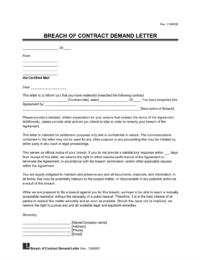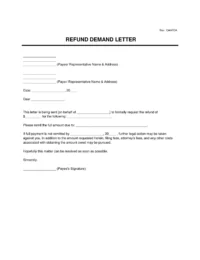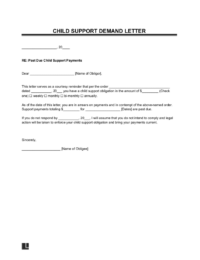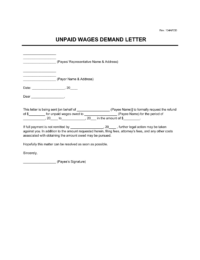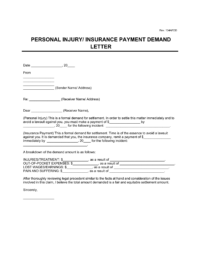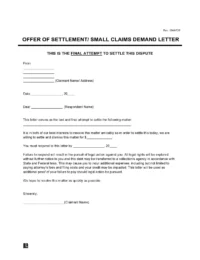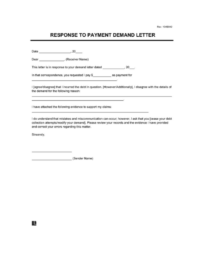A Demand Letter for Payment is typically sent to notify a party that they defaulted on specific financial obligations.
It is a formal written request for payment of a debt that is owed, and it usually outlines the amount owed, the date by which the payment should be made, and the consequences of not making the payment by the specified date.
By Type (9)
A document used to launch breach of contract disputes against a party for violating the terms of an agreement.
Breach of Contract
What Is a Demand Letter for Payment?
A Demand Letter for Payment is a document that informs someone that they are indebted to an individual or company. It includes the reason for the debt and recovery methods and describes what happens if the recipient doesn’t reply or repay the debt before a deadline.
In many jurisdictions, when first recovering a debt, parties first try to recover it through means other than small claims court or a lawsuit. Consider a demand for payment letter as an initial, non-confrontational approach to recovering a debt.
When a Demand for Payment Letter Is Needed
A demand for payment letter is used when someone owes you money. Remember, every situation is fact-specific and should be approached differently. Here are some common cases where a demand for payment letter is recommended:
- Payment has not been received within the agreed-upon time frame.
- Despite contacting the company, they have not remedied the situation within a reasonable period.
- You were billed for a service or product never provided or delivered.
- A company has declined to credit your account, even though you believe you are entitled to a credit.
Because your demand for payment will be used in a court claim, be polite, stick to the facts, and clarify your expectations without being unreasonable or disrespectful.
IMPORTANT
There are situations where a professional invoice template will do. For example, if you are a building contractor and have completed work as agreed, you shouldn’t send a demand for payment on the work completion date.
The Consequences of Not Using a Demand for Payment Letter
There are a couple of potential consequences for not sending a demand for payment.
- You may never get paid. Without sending a demand letter, you may leave money on the table.
- You cannot proceed with a lawsuit if you have not first filed a demand for payment.
How to Send a Demand Letter for Payment
Step 1 – Gather Proof of Debt
- Confirm Details of the Debt: Confirm the amount owed, including any additional fees or interest.
- Compile Contact Information: Ensure you have the correct contact information for the debtor.
- Document Previous Attempts to Collect: Document all previous communication and attempts to collect the debt.
Step 2 – Draft the Demand Letter
We provide a step-by-step guide on how to write a demand letter.
When writing a demand letter for payment, use clear and concise language to detail the amount owed, including any additional fees or interest, and specify a firm deadline for payment. Identify all parties involved and provide detailed payment instructions.
Maintain a professional and polite tone while outlining non-payment consequences, including legal action or reporting to credit agencies.
Step 3 – Review and Send the Letter
- Proofread the Letter: Check for clarity, accuracy, and completeness.
- Use Certified Mail: Send the letter using the United States Postal Service’s certified mail services with a return receipt to have proof of delivery. Find a USPS Location.
- Keep Copies: Retain a copy of the sent letter and the delivery receipt for your records.
Step 5 – Follow-Up
- Monitor the Deadline: Keep track of the payment deadline.
- Be Prepared for a Response: Be ready to receive payment, negotiate payment terms, or take further action as necessary.
- Take Further Action: If the debtor fails to respond or pay, consult an attorney about the next steps, which may include filing a lawsuit.
Step 6 – Mediation or Legal Proceedings
If a debtor fails to respond to a demand letter or does not pay by the specified deadline, you may consider taking further action to recover the debt.
Here’s an expanded overview of the possible steps:
- Negotiate a Payment Plan – If the debtor cannot pay the total amount, consider negotiating a payment plan or agreeing to accept a lesser amount to settle the debt.
- Mediation – If the debtor cannot pay the total amount, consider negotiating a payment plan or agreeing to accept a lesser amount to settle the debt.
- Hire a Debt Collection Agency – Employ a debt collection agency to recover the debt on your behalf. These agencies have experience in debt recovery, but they will typically charge a fee or a percentage of the recovered amount.
- Small Claims Court – You can file a lawsuit in small claims court for smaller debts. This process is generally quicker and less expensive than other court proceedings, but there is typically a limit on the amount you can sue for.
- Civil Lawsuit – If the amount is substantial, file a civil lawsuit in the appropriate court. A successful lawsuit may result in a judgment that the debtor must pay the debt, along with possible court costs and attorney fees.
- Report the Debt to Credit Bureaus – Report the unpaid debt to the major credit bureaus. This action can negatively affect the debtor’s credit score, potentially encouraging them to settle the debt.
How to Write a Demand Letter for Payment
Step 1 – Include Payor and Payee Information
The payor, or debtor, is the person who owes money to the payee or debtee. You must fill in both parties’ contact information in the document, such as their names and address.
You should also include the contact information of someone the payor can contact if they have questions. This individual could be the person creating the letter or related to the payee.
Specify the method of communication by listing either postal mail, phone, or email.
Step 2 – Fill in Payment Information
Write down the payment information, including information regarding the late payment:
- Payment due amount
-
Reason for payment
- E.g., Rent, purchase, account, etc.
- Original payment due date
- Number of days past due
-
Late charges
- If late charges are attached to the payment, specify whether the costs are a set amount or a percentage of the original payment amount.
- Number of days the payor has upon receiving the letter to make the payment before the payee takes legal action.
Step 3 – Fill in the Final Details
Finally, date the letter and then send it to the payor.
What Should Be Included in a Demand Letter for Payment?
You should include certain fundamental information in the demand for payment letter. Such information is detailed below:
- Party information: both the person owed the debt and the person owing the debt should be identified;
- Date debt was incurred: the date the unpaid-for work was completed;
- Date debt was improperly charged: if the dispute surrounds a charge for services not rendered or other improper payments, the date of the charge
-
Details of debt: facts describing the nature of the debt, including:
- The nature of the agreement;
- The amount agreed to; and
- How the agreement was not followed.
- Details of prior attempts to collect the debt: information such as calls made, emails sent, and invoices mailed;
- Expectations for payment: expectations should be clear and definitive, including the date the payment must be made;
- Consequences for non-payment: if the author intends to sue if the debt isn’t paid, this should be included in the demand for payment and;
- Signature: the author should personally sign the document;
Below is a sample language often included in a demand letter for payment:
| Party Information | From: Cam Contractor To: Joe Blow |
| Date Debt Was Incurred | On June 15, 2017, I completed the installation of your patio. |
| Details of Debt | Our agreement was that I would install your patio for $5,000. You agreed to pay me $2500 upfront, and another $2500 upon completion. While you did, in fact, pay me $2500 up front, you have not paid me the $2500 due upon completion. |
| Details of Prior Attempts to Collect the Debt | On June 16, 2017, I sent you an invoice for the remaining balance of $2500, with a due date of July 15, 2017. On July 16, 2017, I sent you another invoice marked “Past Due – Please pay upon receipt.” |
| Expectations of Payment | I expect the balance due of $2500 to be paid within 14 days, which is August 14, 2017. |
| Consequences for Non-Payment | If I do not receive payment by August 14, 2017, I will have no choice but to file a claim in small claims court for the amount due and owing, $2500, as well as any reasonable costs allowed by law. |
Demand Letter for Payment Sample
Below is a sample demand for a payment letter. You can download our free template in PDF or Doc format and fill it out on your own.
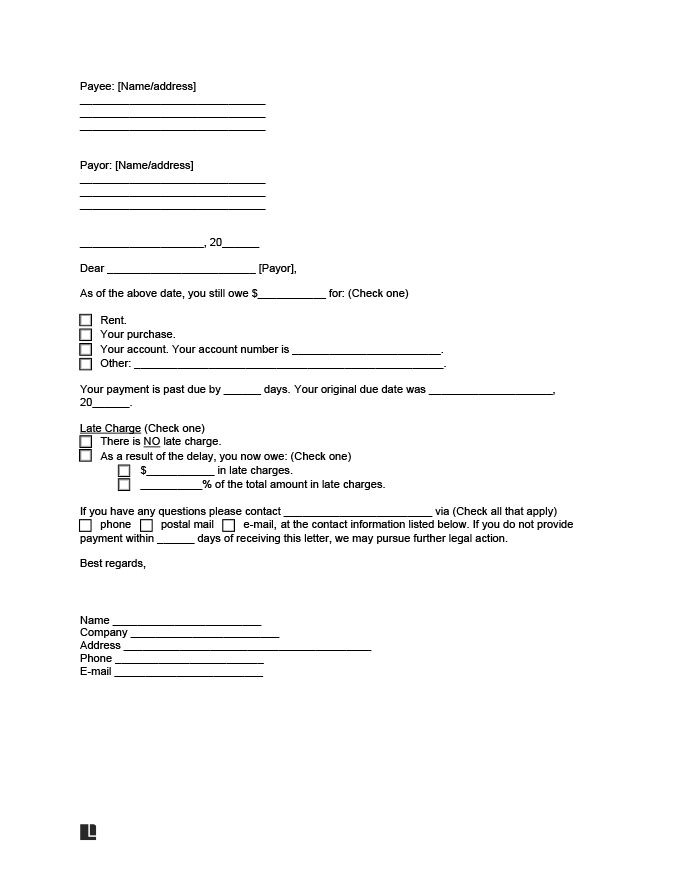
Be sure to send a demand for payment using a method that allows you to obtain proof of receipt. This can be return service requested, certified mail, or through a signature program offered by a private delivery service.
Frequently Asked Questions
Do I need to have the demand for payment notarized?
No, a demand for payment does not need to be notarized. However, if you file a claim in court, you may be required to swear to the truth of the allegations you make about the facts of your case.
Consequently, just as with an affidavit, you should limit your demand for payment to facts. Your demand may later be admitted into evidence in a court of law.
What happens if I send a demand letter and the recipient wants to negotiate payment terms?
You can negotiate payment or stand firm on your original conditions. Only you can decide which course of action is best for you. In any event, make sure to document this exchange in writing.
